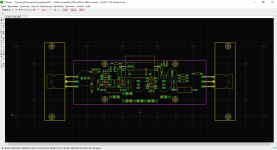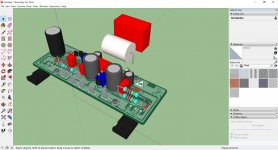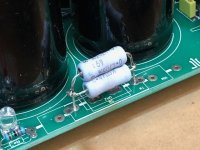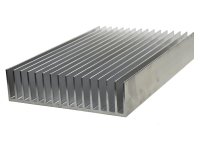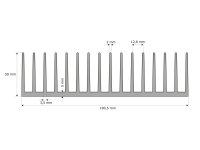Why only fancy bypass capacitors on C102? C111 is very much in the signal path as well.
Ok, we can add that I think - if JPS64 can find some room? I never thought to bypass the shunt capacitor before - thinking it is a shunt but I guess we want it to shunt HF's just as well.
The board does look beautiful and I see you are using double layer traces for extra current capacity (all the vias). Nice touch, but I wonder if board fab houses complain as that is a lot of holes to drill (even by a robot).
Last edited:
I never thought to bypass the shunt capacitor before - thinking it is a shunt but I guess we want it to shunt HF's just as well.
Think about it this way; if you were driving the diff amp with a balanced signal, it would be the (-in).
Could you squeeze in another set of holes or two on R131, the CCS sense resistor? Builders could stack 0.22 or 0.47 vertically.
A question regarding choice of heatsinks, I think I have found a suitable 0,4K/W heatsink from our local store for the 20W amplifier version, with an estimated 96W dissipation per channel if I understand it, it would mean one heatsink for one channel would reach a temperature in the vicinity of 60-65C in room?
One thing I am a bit hesitant over is whether the aforementioned heatsink base thickness of 5mm is good enough considering that the heat sources is rather concentrated only over one pair of output FET's.
Thanks Hugh for offering the DiyA community with such an exquisite amplifier circuit and XRK for the build, pictures and measurements.
Regards Michael
Thanks for the warm and cozy welcome to the frat party, I assume the silence to my previous posts conundrums is to be interpreted as the aforementioned heatsink should be good enough for the 20 Watt amplifier version presented in this thread.
Attached some picture in case there would still be any objections on the chosen heatsink which measures 300 x 190 x 50 mm, and with a base plate thickness of 5 mm, they are available from a local store for 37€ each.
Attachments
Ultima Thule,
Those heatsinks look fine for the 20W version. You could probably use it for the Big Boy 52W if aided by a fan.
Those heatsinks look fine for the 20W version. You could probably use it for the Big Boy 52W if aided by a fan.
Michael,
I'm not quite sure I agree with X, 0.4C/watt would take it 38.4V ABOVE ambient. If you have around 20C in your room, usual in Oz but maybe 2C more than in northern Europe, you would be running the heatsink, assuming perfect heat distribution, around 58.4C. That's about 10C above I'd want to run an output device; I shoot for 48C maximum. Remember that with Class A it will be a close constant dissipation; these amps get very hot.... I remember from my Glass Harmony in the nineties which run two 300mm x 150mm heatsinks for total 150W dissipation, so 75W on each heatsink, much less than the ALPHA 20, and it was almost too hot to touch.
You have to be very careful with heat dissipation in Class A, although of course mosfets are more thermally robust than bipolars....
Given that a very large heatsink in still air will be too hot, consider X's solution using a Dell CPU cooler. They are very elegant, and about the same price, but will dissipation more heat. One could do around 100W with ease. Another option would be two smallish sinks with many fins atop a slow speed 120x120 Noctua fan, or any other fan which is very quiet, which then drives the cooling air UP to maximise convection and rising hot air movement.
Cheers,
Hugh
I'm not quite sure I agree with X, 0.4C/watt would take it 38.4V ABOVE ambient. If you have around 20C in your room, usual in Oz but maybe 2C more than in northern Europe, you would be running the heatsink, assuming perfect heat distribution, around 58.4C. That's about 10C above I'd want to run an output device; I shoot for 48C maximum. Remember that with Class A it will be a close constant dissipation; these amps get very hot.... I remember from my Glass Harmony in the nineties which run two 300mm x 150mm heatsinks for total 150W dissipation, so 75W on each heatsink, much less than the ALPHA 20, and it was almost too hot to touch.
You have to be very careful with heat dissipation in Class A, although of course mosfets are more thermally robust than bipolars....
Given that a very large heatsink in still air will be too hot, consider X's solution using a Dell CPU cooler. They are very elegant, and about the same price, but will dissipation more heat. One could do around 100W with ease. Another option would be two smallish sinks with many fins atop a slow speed 120x120 Noctua fan, or any other fan which is very quiet, which then drives the cooling air UP to maximise convection and rising hot air movement.
Cheers,
Hugh
Last edited:
You can always drop the bias current a tad and adjust for max temperature. My Silicon Harmony runs at 56C. It’s too hot to hold with pressure but won’t burn you. The CPU coolers are actually less expensive than passive heatsinks. I got mine for $12 and added a $1 fan.
I am lucky, I get to listen to the ALPHA as I am typing. Even in mono, it sounds gorgeous - there really is something special sounding here.
First up is "Ain't no sunshine" by Buddy Guy featuring Tracy Chapman has true impact and realism. Wow, very nice rendition on my full range W5-2143 in an XKi cabinet.
Next up is Natalie Merchant's Carnival - superb kick drum impact on the intro. Guitar sounds amazing.
Then Barracuda by Heart - nice clarity of the guitar intro which is very dry and distinct.
Now "Californication" by Red Hot Chilli Peppers - superb bass and visceral depiction of Anthony Keidis's voice.
Then we have "Rosemary" (Live at the Stephen Talkhouse) by Suzanne Vega - masterful recreation of the emotion of the recording.
It's a wonderful amp, perhaps one of the best I have heard.
Thank you, Hugh!
First up is "Ain't no sunshine" by Buddy Guy featuring Tracy Chapman has true impact and realism. Wow, very nice rendition on my full range W5-2143 in an XKi cabinet.
Next up is Natalie Merchant's Carnival - superb kick drum impact on the intro. Guitar sounds amazing.
Then Barracuda by Heart - nice clarity of the guitar intro which is very dry and distinct.
Now "Californication" by Red Hot Chilli Peppers - superb bass and visceral depiction of Anthony Keidis's voice.
Then we have "Rosemary" (Live at the Stephen Talkhouse) by Suzanne Vega - masterful recreation of the emotion of the recording.
It's a wonderful amp, perhaps one of the best I have heard.
Thank you, Hugh!
Last edited:
X,
The early impressions are very encouraging. 🙂 You planning to be patient enough to wait for the boards to get stereo, or go your usual route? 😀
The early impressions are very encouraging. 🙂 You planning to be patient enough to wait for the boards to get stereo, or go your usual route? 😀
- Home
- Amplifiers
- Solid State
- Aksa Lender P-MOS Hybrid Aleph (ALPHA) Amplifier
